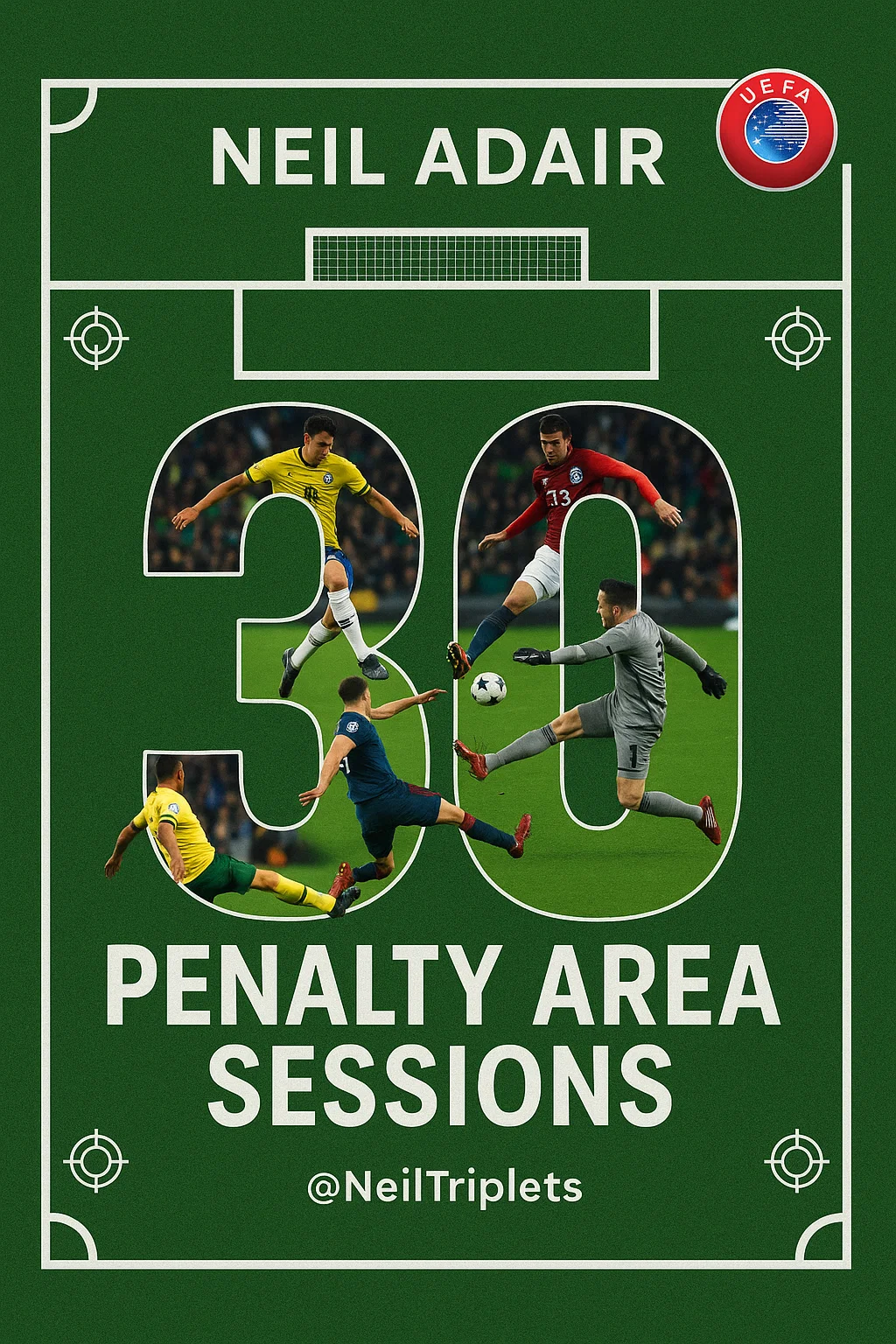
30 PENALTY AREA SESSIONS: MASTERING THE DECISIVE ZONE
Introduction: Where Matches Are Won and Lost
In football, the penalty area is the crucible where games are decided. It is the stage for moments of clinical finishing, desperate last-ditch defending, and explosive athleticism. While possession and build-up play dominate tactical discussions, a team’s proficiency inside these 18 yards often separates contenders from champions. Consequently, dedicated training focused on this critical area is not a luxury; it is an absolute necessity. This article explores the art of designing effective penalty area sessions, providing a framework for 30 practices that will sharpen your team’s instincts, improve their conversion rate, and fortify their defensive resilience where it matters most.
For a foundational understanding of structuring all aspects of coaching, the UEFA B License Coaching Manual PDF is an excellent starting point.
The Dual Focus: Attacking and Defending in the Box
Effective penalty area training must address both sides of the game. The principles for attackers and defenders are distinct yet intrinsically linked, creating a dynamic and competitive learning environment.
The Attacking Mindset: Precision and Instinct
For attackers, the penalty area is a space of limited time and space. Training must therefore develop:
- First-Time Finishing: The ability to shoot accurately with one touch, under pressure, from various crosses and cut-backs.
- Movement: Mastering runs to lose markers—near post, far post, checking, and bending runs.
- Heading Technique: Powerful and directed headers from both crosses and set-pieces.
- Composure: The mental calmness to execute technique when fatigued and under intense pressure.
The Defensive Mindset: Discipline and Aggression
For defenders, the priority is to protect the goal at all costs. Key training points include:
- Zonal Marking: Understanding and controlling space, particularly for set-pieces.
- Man-Marking: The strength and awareness to stay goal-side and track runners.
- Clearance Techniques: The ability to decisively head or kick the ball to safety, not into dangerous areas.
- Goalkeeper Communication: Organizing the defensive line and claiming crosses authoritatively.
Designing Effective Penalty Area Sessions: A Framework
Merely taking shots from crosses is not enough. A progressive training model ensures all aspects are covered.
Phase 1: Technical Development (Isolated Skill Work)
Objective: To build the fundamental technical skills without defensive pressure.
- Session Examples (1-10): These initial sessions focus on repetition. Drills include:
- Finishing from Service: Repetitive shooting from volleys, half-volleys, and headers from wide and central areas.
- Crossing Variations: Drills focusing on different types of crosses: driven, lofted, and cut-backs.
- Goalkeeper Handling: Specific training for shot-stopping, dealing with low drives, and claiming crosses.
- Resource: Use dynamic Warm-Up Exercises with Ball PDF that incorporate finishing to start these sessions effectively.
Phase 2: Tactical Application (Phase of Play)
Objective: To introduce tactical decisions and light pressure, replicating game scenarios.
- Session Examples (11-20): These sessions integrate movement and decision-making.
- Attacker vs. Defender Drills: 2v2 or 3v3 scenarios in the box, focusing on specific types of runs and defensive tracking.
- Set-Piece Routines: Dedicated time for designing and rehearsing corner and free-kick plays for both attack and defense.
- Rebound and Second Ball Drills: Training reactions to parried saves and loose balls in crowded areas.
- Resource: The attacking principles drilled here are part of a larger framework, as seen in the Principles of Play: Attacking PDF.
Phase 3: Integrated Training (Fully Opposed & Conditioned Games)
Objective: To place players in high-intensity, game-realistic situations that test all skills under fatigue.
- Session Examples (21-30): These are the most demanding and effective sessions.
- Conditioned Games: Small-sided games (e.g., 5v5) where the only way to score is from a cross or a one-touch finish inside the area.
- Transition to Finish: Drills that start in midfield with a build-up, culminating in a rapid attack into the penalty box.
- Pressure Training: Finishing drills performed at the end of a high-intensity fitness circuit, simulating the physical state of a late-game chance.
- Resource: These high-intensity, game-based drills are a staple of advanced coaching, as explored in UEFA A Coaching Session Plans and UEFA B License Coaching Sessions PDF.
Furthermore, incorporating variety is key to maintaining engagement. A resource like 60 Training Games PDF can provide numerous small-sided game ideas that can be conditioned to focus on penalty area actions.
Conclusion: Forging a Clinical and Resilient Mentality
In conclusion, mastering the penalty area is about more than just technique; it is about forging a mentality. For attackers, it is the cold-blooded instinct to seize a half-chance. For defenders, it is the unwavering desire to protect the goal. The 30 sessions outlined provide a pathway to develop both, moving from isolated technical repetition to fully integrated, high-pressure scenarios that build confidence and competence.
The difference between a good team and a great one is often their efficiency in both boxes. By dedicating consistent time to these focused sessions, you are investing directly in your team’s results. The work of elite academies, such as those detailed in the Leicester City Football Club Academy PDF, shows the value placed on specialized finishing and defending.
To continue developing your coaching expertise, consider furthering your education through courses like the UEFA Pro License Course PDF or the AFC B Diploma Coaching Course Certificate PDF. For daily insights and analysis from the world’s best, follow top coaches and analysts on @CoachesVoice and read tactical breakdowns on The Athletic.
Remember, a comprehensive The Training Plan always includes dedicated time for the decisive zone. By making these 30 penalty area sessions a core part of your regimen, you ensure your team is prepared to win those critical moments that define seasons.
